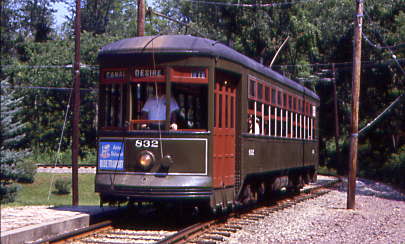
Chris Parker and I left Galliztin after a great night at the Tunnel Inn and drove to US 22 which we took west. At Ebersburg, Chris needed to send a fax for his tree-cutting business so after two stops, we found a location. Back west on US 22, we went to New Alexandria then took US 119 south through Greensburg down to Interstate 70 west to just east of Washingtonm where we turned left onto Interstate 79 North, taking the road to Exit 41.
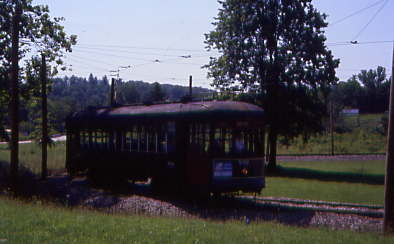
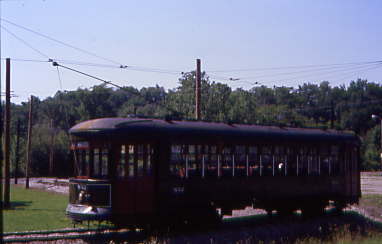
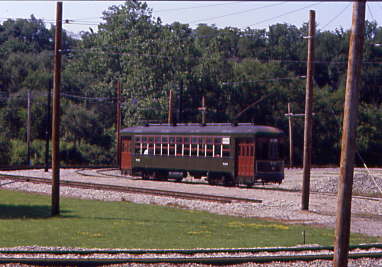
From here we followed the signs to the Pennsylvania Trolley Museum and as we did so, saw New Orleans Public Service Company 832 built by Perley Thomas Car Company in 1923 approaching the east turning loop so we stopped. Once done, we drove the rest of the way down the road to the museum's grounds.
Pennsylvania Trolley MuseumStreetcars served America through two world wars and a depression, but affluence and automobiles caused the end of the Trolley Era and a greatly diminished role for public transportation. As streetcars were phased out, groups formed to preserve trolleys with the goal of operating them for future generations. One such group was the Pittsburgh Electric Railway Club, which was formed in 1946 by members of the Pittsburgh NRHS (National Railway Historical Society) chapter which had preserved a car prior to World War II. This car was lost to the scrap drive as members were occupied with their duties overseas and on the home front. Still the dream lived on. PERC members purchased their first streetcar in 1949, added a second car in 1952 and a third in 1953. With acquisition of a site in Chartiers Township, Washington County and the wonderful cooperation of the Pittsburgh Railways Company, the three-car collection motored to the site on February 7, 1954 to establish the first Trolley Museum in Pennsylvania with operation by trip attendees.
First known as Arden Electric Railway, this pioneering effort has over several decades become the Pennsylvania Trolley Museum. Construction of a car house building, repair of track and overhead lines followed and on December 8, 1962, the streetcars were once again operational on the Museum's one mile ride. On June 23 of the following year the museum received its first official visitors after a ribbon-cutting ceremony. Since then, the museum has seen several decades of expansion. The car collection, the existing track, the car house and visitor buildings have all seen major growth. Today, the Pennsylvania Trolley Museum owns nearly 50 street and electric railway cars, 20 of which are operational on the museum's four mile ride. Each year over 30,000 visitors are treated to a hands-on, moving history lesson.
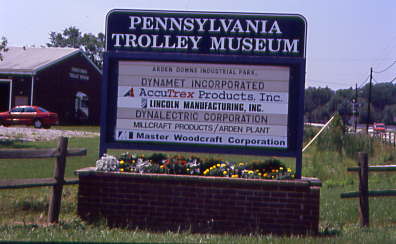
The sign that greets you upon arrival.
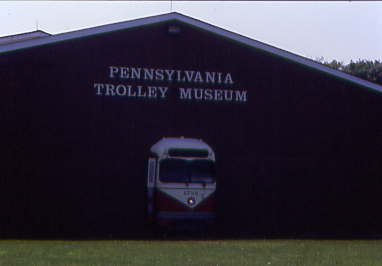
The main building has a unique face on it, the front of a trolley. We parked under the trees on this very hot and humid day and I used yet another coupon from the Tourist Train 2006 book then we started to explore.
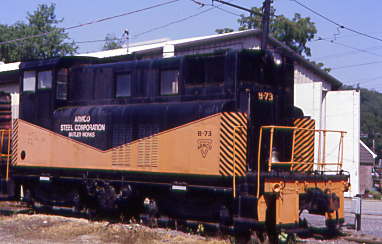
Pennsylvania Trolley Museum boxcab diesel B73, ex. American Rolling Mills Company B73, nee American Steel and Wire Division of United Steel 1 built by Baldwin Locomotive Works/Westinghouse Electric Corporation in 1930. Newer and larger diesels sidelined B73 in 1965 and in 1970, ARMCO donated the unit to the museum after generously rebuilding the trucks with new wheels. It remains in operating condition and is used occasionally to shift our standard gauge rolling stock and can also be used to power the trolleys during long outages.
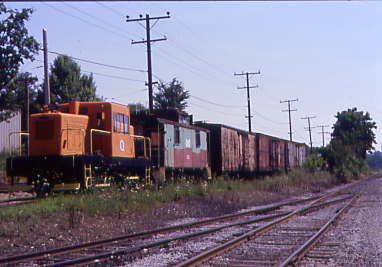
A line of railroad equipment with the former Pennsylvania Railroad branch line now operated by the Pittsburgh & Ohio Central in the foreground.
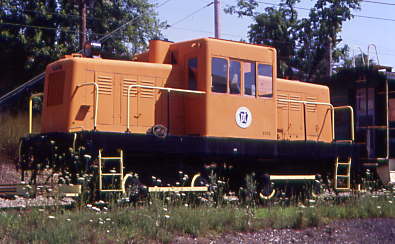
Pennsylvania Transformer Technologies Corporation 1311 built by Porter Locomotive Works in 1942. The museum's second diesel locomotive acquisition also reflects products of the Keystone State, and of the Pittsburgh region in particular. Between 1867 and 1950, the H.K. Porter Company built more than 7,800 locomotives at its factory in Pittsburgh's Lawrenceville neighborhood. Porter specialized in smaller locomotives for mines, mills and, especially during World War II, the U.S. military. Locomotive 1311 was built for the U.S. Navy in 1942 and delivered to a facility in New Jersey, where it worked until declared surplus in 1955 and sold to a used equipment dealer. The following year, it was purchased by Pennsylvania Transformer Company in nearby Canonsburg.
It worked there in relative obscurity until displaced by a larger diesel about 1990, when it was placed in storage. PTM approached the successor, Pennsylvania Transformer Technology, Inc. (PTT), in 1998 and requested donation of the locomotive. PTT agreed, and not only gave 1311 to PTM but also allowed us to keep it at their plant while PTM volunteers repaired and repainted it. Transportation to the Museum was donated by the Pittsburgh & Ohio Central Railroad in May 2002. Locomotive 1311 weighs 43 tons and is powered by twin 150hp Cummins Diesel engines. Each engine drives a Westinghouse Electric generator, which in turn powers an electric motor in one of the trucks. As designed for slow switching service, 1311 is powerful for its size but is limited to a top speed of 20mph. It remains functional at PTM and, like B73, is occasionally operated for special events and to shift our storage boxcars when required.

Monongahela Railway caboose 73 built by International Car Company in 1949. It was donated to the Museum by the Monongahela Railway, a 170-mile coal hauling railroad headquartered in Brownsville, Pennsylvania in July 1991 and was transported to the Museum by Conrail the following month. These were the only steel cabooses that the Monongahela purchased new; all previous cars had been of wooden construction. Four of these cars remained in daily service until September 1990, when they were displaced by secondhand (but much newer) bay window style units. By this time, the cupola style caboose had become a rarity in Western Pennsylvania, surviving only on a few short line railroads.
As originally equipped, 73 had bunks for a five-person train crew, oil lamps and a coal stove. Train crews often stayed overnight at distant terminals in their caboose, hence the full accommodations. Electric lights later replaced the oil lamps, and two bunks were supplanted by a rest room, but the coal stove persists to this day.
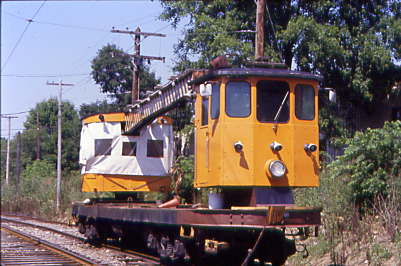
Pittsburgh Railways crane car M283 built by Differential Car Company in 1929 and was specially designed for use by electric railways. One of the special features of this car is its ability to work under trolley wire. Its patented design allows for a maximum height above the rail of 12'3" and the crane swings in a complete circle. Allowance is also made so that the crane will not interfere with streetcars passing on opposing tracks when reaching off to the side.
These cars were designed to perform a wide variety of tasks including the setting of line poles, placing and removing track and transporting materials. Tcrane tub and the operator's cab are designed with clearance underneath to allow the car to carry long items like rail and poles. Optional features of the car included a clamshell bucket for digging, a boom extension and air-hydraulic wing plows attached to the sides of the car. These wings and an optional wedge- shaped plow attached to the end of the car could be used for grading and snow removal.
During its life at Pittsburgh Railways, the car was assigned to the Ways and Structures Department and stationed at Millvale Car House. In 1973, the car was completely rebuilt by Port Authority Transit (into whose ownership it had by then passed) following a derailment. At that time it received a new operator’s cab and rebuilt trucks. When the light rail system opened in 1984, the car was converted to pantograph operation. Problems with the mounting of the pantograph and the car;s safe operation on the new computerized system ultimately rendered it surplus in 1989, and it was acquired by the museum. Since that time it has proven to be an indispensable tool for developing our museum as well as a unique and interesting display.

Car Barn 2.
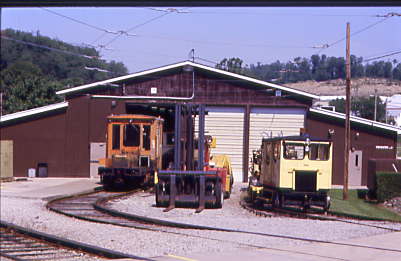
Car Barn 1.

Philadelphia Transportation Company 2711 built by St. Louis Car Company in 1947. Philadelphia Transportation Company (PTC) had a large fleet of PCC streamliners, of which 2711 (along with sister car 2723) represents one of the more recent. Originally built for service on the busy 23-Germantown Avenue line, the car came equipped for 2-man operation - almost unheard of in 1947, but traffic on the route more than covered the extra operating cost. As PTC gave way to SEPTA (Southeastern Pennsylvania Transportation Authority) in 1968, the 2700s continued in service and remained after several trolley lines had been discontinued. Because of their age, many cars went through a general overhaul rebuilding in the 1980s to extend their useful life another ten years, including the replacement of the hand-cranked windows with school bus style windows and seating from scrapped former transit buses. But once that time was up and new cars were acquired, streetcar operation was sharply curtailed and the cars were surplus. In 1999 car 2711 was acquired by PTM for the purpose of having a wheelchair accessible car for operations. The generosity of corporate partner Adtranz (now Bombardier) that builds people mover cars and components in nearby West Mifflin allowed the car to be taken from Philadelphia to their factory in Elmira, New York where crews restored the original 1947 appearance. As a work car 2711 had many of its seats removed which facilitated reworking of the interior.
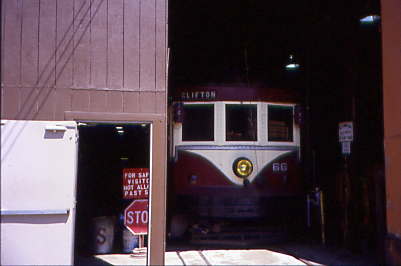
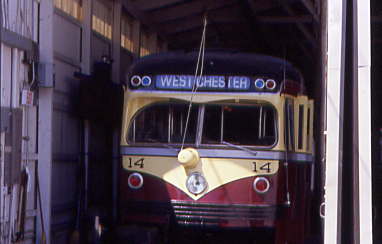
Philadelphia Suburban 14 built by St. Louis Car Company in 1949. The St. Louis cars were delivered in May and June 1949 and represent what many consider to be the last interurban cars built in America. Their arrival permitted Red Arrow to retire a group of Jewett-built interurbans dating to 1913, and several two-man center door cars like cars 66 & 73. While these cars are equipped with the same high-speed running gear as the Brilliners, they also have multiple unit capabilities (can be coupled together in pairs) and two-way radios. These important features were required to expand service along the rapidly developing West Chester line, which operated on single track over the majority of its 19-mile length.In 1954, the widening of Pennsylvania Route 3 brought the decision to abandon the line to West Chester, after which the "Louie" became the mainstay of operation for the remaining rail lines. Cars 14 and 24 were withdrawn from regular service in September 1982 following acceptance of 29 new LRVs Two St. Louis-built cars were selected for preservation here at the Museum because they will demonstrate the operation of streetcars in multiple unit. Work on 14 was the most complex trolley restoration undertaken to date by our crew. Pennsylvania Trolley Museum volunteers began work on this project in the summer of 1997 and returned to car to service at the Museum in June 2004.
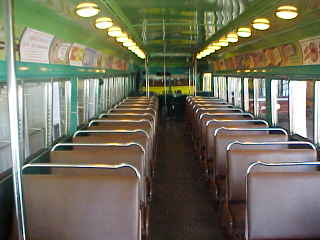
Interior of Philadelphia Suburban 14.

Philadelphia & West Chester Traction 78 built by the J.G. Brill Company in 1932. The onset of the Great Depression brought with it a spiraling decline in the revenue and ridership of most streetcar companies. For many lines, the only answer was abandonment or motor buses. Car 78 is one of a group of ten cars purchased from the J.G. Brill Company in 1931 and 1932 by the Philadelphia and West Chester Traction Company as part of a bold plan to combat the decline while maintaining the financial health of the company through the tough economic times.
The "80 cars", as they became known, were designed for one-man operation, equipped for high-speed running and employed lightweight aluminum construction. The cars were so successful that five additional cars were ordered even before the initial five cars ordered had been fully delivered. These new cars were cheaper to man, and reduced power consumption, while their high-speed equipment cut the scheduled operating times and made the service even more attractive to potential riders. This, coupled with a fare reduction and consolidation of other competing forms of transit in the area enabled the management to stave off the effects of the terrible economic times, and go on to build one of the most successful privately-owned transportation companies in the country.
The consolidation of streetcar and bus operations by the Philadelphia and West Chester Traction Company in the early 1930's gave rise to discussion of changing the corporate name to better reflect the new, diversified business. In 1936, the company became the Philadelphia Suburban Transportation Company, and adopted the "Red Arrow Lines" logo as part of a carefully planned public relations campaign. The "80 cars" served Philadelphia's western suburbs for 50 years. Their last 15 years of service saw them used primarily in rush hour service.
Car 78 was withdrawn from service and acquired by the museum in September 1982. To the collection, it represents the transition in electric railway design, construction, and technology between arch roof cars and the PCC.
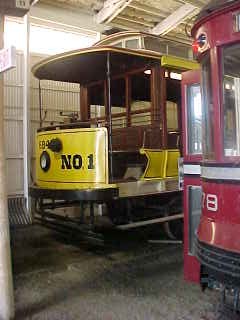
Rio de Janeiro Tramways 1758 built by Rio de Janeiro Tramways in 1911. No other streetcar attracted the riding public's attention quite like the open car. One hundred years ago, summer trolley rides were advertised as the perfect way to cool off, and the companies did a brisk business taking passengers to parks or for a ride in the country. Many trolley companies built those parks that became the destinations – it was simply good business! As safety became more of an issue, due to autos sharing the streets, open trolleys in most American cities disappeared in the late 1920s. In Rio de Janiero, however, use of the cars continued into the 1960s, when a dozen cars of JG Brill design and Brazilian manufacture were brought to the United States by a group of trolley museums. Car 1758 is one of these cars. It is the same Brill Narragansett design as open cars operated by West Penn Railways in Westmoreland and Fayette Counties, although the West Penn opens were wider and longer. Car 1758 was originally purchased and restored by the Magee Transportation Museum in Bloomsburg, Pennsylvania. It was restored and then operated there as Magee Museum 3, until that museum's untimely closure as a result of extensive damage from Hurricane Agnes in 1972.
The car was purchased in 1973 and moved to New Jersey where it was used as a prop inside a hobby shop. The owner of this shop retired to Florida and the car accompanied his move. It was set up inside the Lionel Train and Seashell Museum in Sarasota, Florida, where it was used indoors as a display and as a seating area to watch videos. In 1990, the car was purchased by the City of Orlando, Florida. It was to be used as the first streetcar (and as a device to generate public interest and Federal funding) for a proposed Heritage Streetcar line in Orlando. The car was refurbished, re-numbered 1 and given the nickname of "Oscar" (for Orlando Streetcar). Unfortunately, Orlando never created the proposed Heritage Streetcar line, and 1758 sat unused in indoor storage for many years until being sold at auction in 2006.
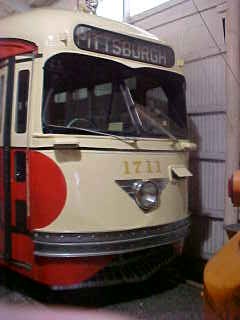
Pittsburgh Railways Company 1711 built by St. Louis Car Company in 1949. Pittsburgh's newest PCC cars were unquestionably the most distinctive. These last 100 units, delivered in 1948-49, differed in many ways from the cars that had come before them. From the outside, the most distinctive changes included the sealed windows (to prevent accidents) with small standee windows (windows for standing passengers) in a row above. On the front of the car, bright triangular wings again outlined the headlight and small dash lights flanked the top corners. On the roof, a cowling running the length of the roof provided intake for the car's ventilation system. Inside, a new seating arrangement allowed all of the passengers to face forward, while four large Sturtevant fans punctuated the ceiling, providing fresh air in lieu of openable windows. A special group of 1700s (numbers 1700-1724) were equipped with special running gear for service on Pittsburgh Railways' long Charleroi and Washington interurban lines: a package shelf in place of the first seat behind the operator, a ticket printer, an emergency tool kit, a spare trolley pole secured in special brackets on the roof and a roof-mounted headlight. After acceptance, 1711 was one of seven cars assigned to Tylerdale car house in Washington.
It was chosen for preservation at PTM because it operated on the line which became our museum home, and also because it was historically significant as the last car to carry regular passengers from Washington to Pittsburgh early on the morning of August 30, 1953. Car 1711 was retired from active service in August 1988, and acquired from Port Authority Transit in April 1990. On the way to the museum, 1711 was detoured to the BarrCannon Body Company in Meadowlands where workmen overhauled it inside and out, under the watchful eye of founding member George Tucker, who also generously donated the cost of the work performed. Subsequently, 1711 was sent to the Adtranz (now Bombardier) facility in Elmira, New York for a complete structural rebuild. During that process, the interior was restored to the original 1949 appearance.
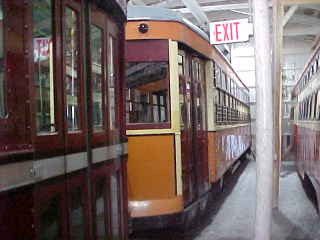
Photography was difficult inside this car barn. That ended the tour and I walked over to Car Barn 1 where restoration takes place.

Boston Elevated Railway Company 3618 built by Differential Steel Car Company in 1927 for use in track construction on the streetcar lines of the Boston Elevated Railway in Massachusetts. Its job was to carry ballast to construction sites and then spread the rock on top of the ties so that it can be used to raise and level the track. This hopper dump car is unusual because most electric railway companies used side dump cars for this job. In fact, fewer than ten cars of this type are known to have been built by Difco.
Construction work on trolley lines diminished considerably after the Great Depression, but 3618 remained on as a maintenance car. Because of its low clearance and in spite of its all-metal construction, it was used for emergency overhead wire work in the trolley subway in Boston. Its last use was in 1959 when a portion of the Boston and Albany Railroad was converted for use as a streetcar line.
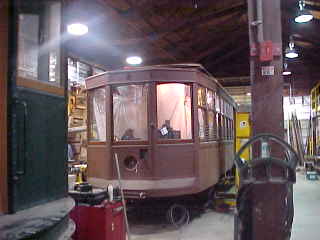
Pittsburgh Railways Company 3487 built by St. Louis Car Company in 1905. Trolley patronage grew dramatically after 1900, necessitating larger streetcars than the first four-wheelers. Car 3487 is an early example of a heavy eight-wheel model. Underneath the steel sheeting is an almost all-wood design. The car's powerful motors allowed trailers to be towed for even more capacity. This is the type of car that opened service on the Charleroi interurban route in 1902. Car 3487 was converted for work car duty in 1934 (it was based at the Charleroi Car House) and thus survived into the 1950s, when it was acquired by the Museum. It is the last of its type.
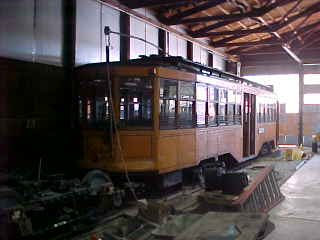
Pittsburgh Railways Company 3756 built by Osgood Bradley Car Company in 1925. During the nation's Bicentennial celebration in 1976, a group of civic officials and PATransit cooperated in returning 3756 to the streets of Pittsburgh as part of July 4th festivities. The car was given new upholstery and fresh paint, and was routed through downtown streets giving old-fashioned 10 cent rides to over 5,000 nostalgic Pittsburghers. Car 3756 returned to Pittsburgh again on May 22, 1987 to provide historical perspective to the most significant development in Pittsburgh's transit system since the introduction of electric cars in the late 1880s: the grand reopening of the South Hills Light Rail line. For this historic operation, PAT technicians fitted the car with a pantograph current collector so that it could operate freely on any part of the new LRT system.
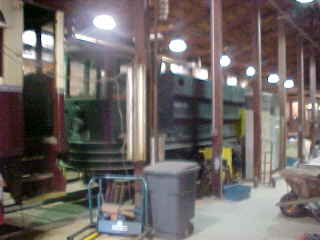
Boston Elevated Railway Company 3618 built by Differential Steel Car Company in 1927 for use in track construction on the streetcar lines of the Boston Elevated Railway in Massachusetts. Its job was to carry ballast to construction sites and then spread the rock on top of the ties so that it can be used to raise and level the track. This hopper dump car is unusual because most electric railway companies used side dump cars for this job. In fact, fewer than ten cars of this type are known to have been built by Difco.
Construction work on trolley lines diminished considerably after the Great Depression, but 3618 remained on as a maintenance car. Because of its low clearance and in spite of its all-metal construction, it was used for emergency overhead wire work in the trolley subway in Boston. Its last use was in 1959 when a portion of the Boston and Albany Railroad was converted for use as a streetcar line.
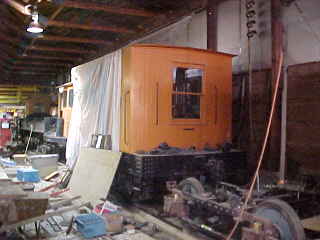
West Penn Railways boxcab locomotive 1 built by the company in 1915. It has the distinction of being the last car of the extensive West Penn Railways system to operate under West Penn ownership. During its 41 years in operation, Number one was used to shift railroad freight cars at West Penn's main shop, car barn and operations center in Connellsville, Pennsylvania. Originally built as a standard railroad gauge unit, it was soon converted to wide gauge of five foot-two and one-half inches to match that of the streetcar system. Switching railroad equipment thus required the use of three rail or dual-gauge trackage with a rail common rail and a rail for each gauge.
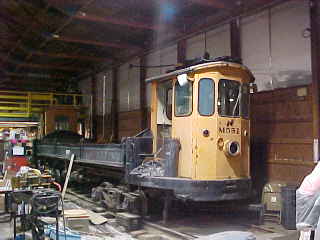
Pittsburgh Railways M551 is one of six such cars built for the Pittsburgh Railways Company in 1922 by the Differential Steel Car Company of Findlay, Ohio. When purchased, it became part of a fleet of eleven side dump cars owned by Pittsburgh Railways Company, and it represents one of the most common types of work cars used by streetcar companies in North America. For Pittsburgh Railways, the side dump car was a natural because the topography of the Steel City provided many instances where embankments along hillsides and streams often required filling-in after landslides or washouts. This need, coupled with the task of removing cinders from the main power station on Brunot’s Island provided these rugged cars with plenty of work for many years.
Over-the-road trucks ultimately replaced dump cars. By the early 1960s, maintenance of just a few isolated areas along the Library and Drake lines had reduced the need for dump cars to just one. In 1977, Port Authority Transit shop crews rebuilt M551 with new cab ends. The car was ultimately retired in 1984 when new equipment obtained for the light rail system rendered it surplus. Today, M551 performs the work it was designed to do at the museum, delivering ballast to track work areas and filling washout areas on our line, most recently after Hurricane Ivan washed out parts of the roadbed in September 2004.
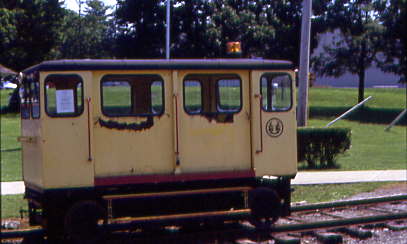
Union Railroad speeder 396 built by Fairmont in 1979.
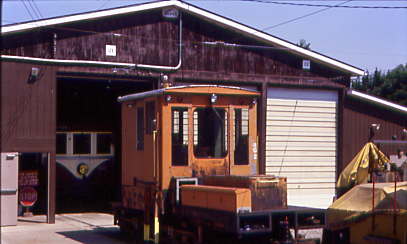
Pennsylvania Trolley Museum 25 ton switcher 89 built by General Electric in 1953. Originally built to switch railroad freight cars at an industrial plant in Eastern Pennsylvania, it is undergoing a conversion to match the broad gauge track width used by the museum's demonstration railway. When completed, it will service PTM as our shop switcher, to move equipment in and out of the repair and restoration shop, as a rescue locomotive should a trolley be stranded out on the line by any sort of electrical problem, and as a snowplow to clear the trackage for winter operations.
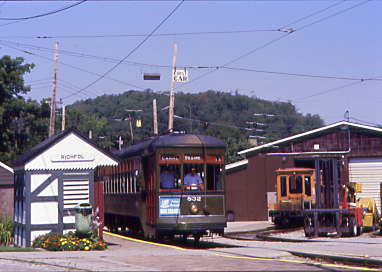
Out on the line was New Orleans Public Service 832 and we waited for its return.
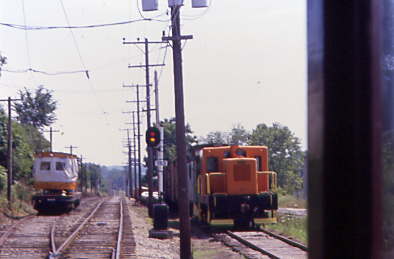
We boarded and proceeded east, passing the equipment I photographed earlier.
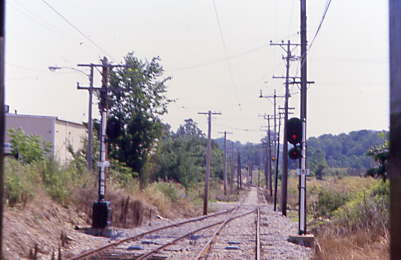
Rolling past the end of that siding.
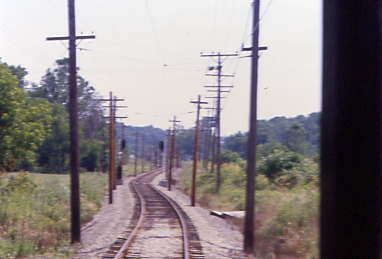
A slight curve on a beautiful, but hot and humid day.
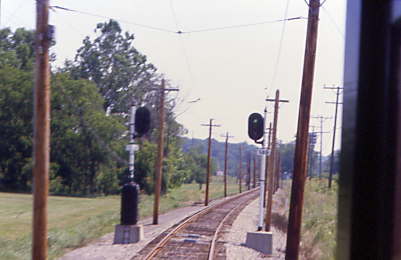
Passing a set of block signals.
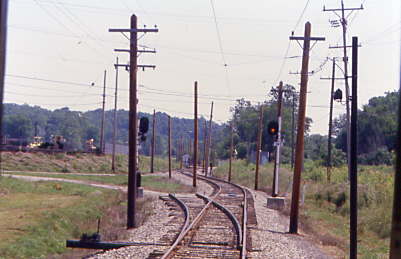
At the future site of a junction to Car Barn 3.
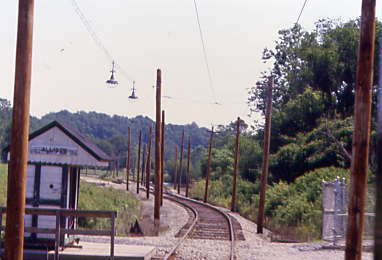
Passing eastbound through Allison.
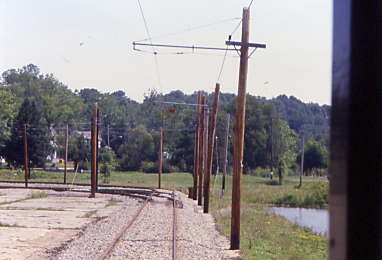
Approaching the south loop which we went around.
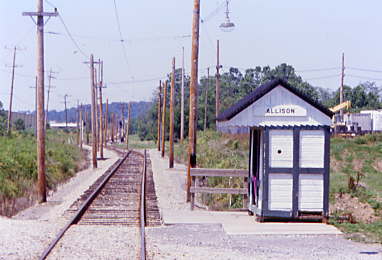
Allison looking west.
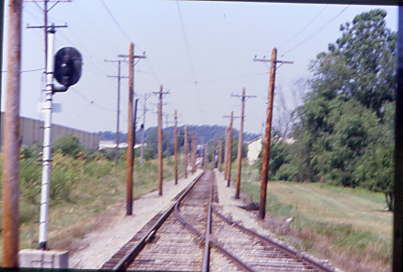
Back at the future wye site near Car Barn 3.
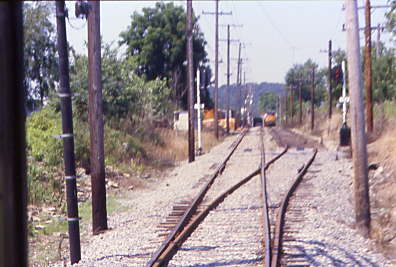
Rolling back through the yard.
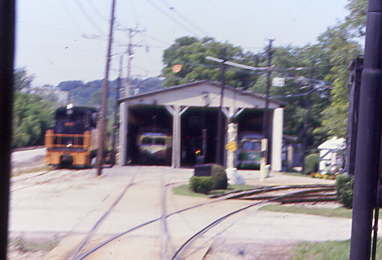
About to curve by Car Barn 2.
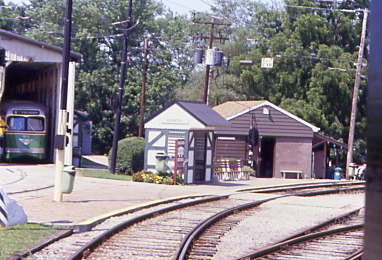
Our trip continued as we ran through the station where we started and now would head to the north loop.
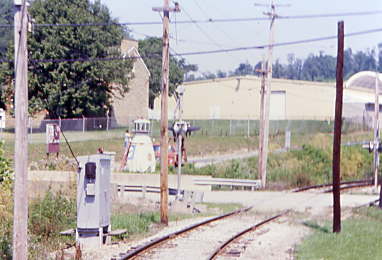
Crossing the highway in front of the museum with a small lighthouse.
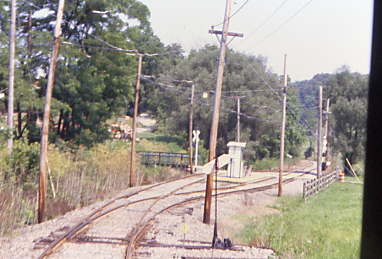
Rolling up to the Fairground Station.
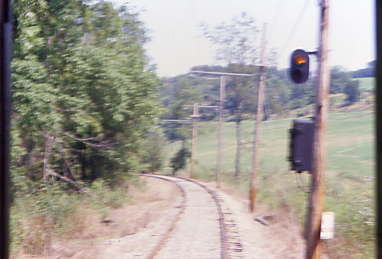
We had now entered the Pennsylvania countryside.
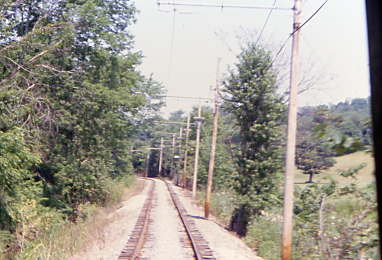
A well-maintained railroad.

About to make a slight curve.

Continuing to roll north.
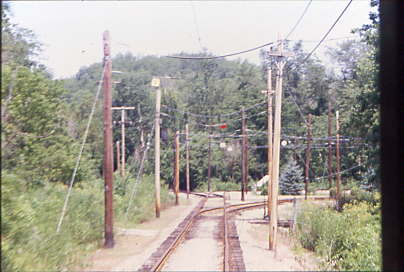
About to go around the north loop.

After we went around the loop, I was allowed off for a quick picture.
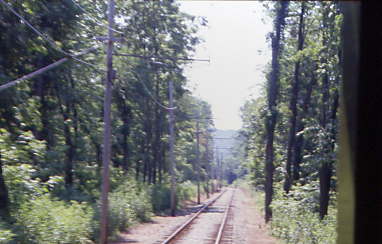
Passing through some beautiful countryside.
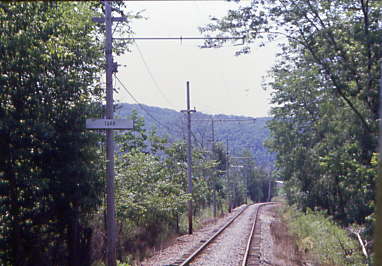
Tarr.

Back at the Fairground stop.
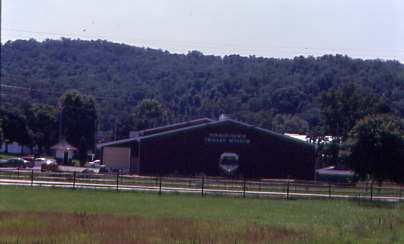
The museum as seen from the trolley.
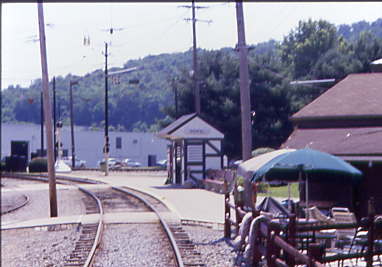
Returning to the museum station and I thanked the crew for a great ride as I detrained.
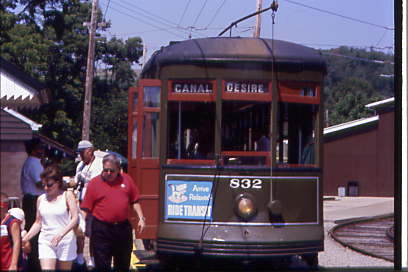
Passengers detrolley as Chris thanked the crew and we returned to the car, ending a most interesting visit to the Pennsylvania Trolley Museum.
Back on the Road Again!We re-entered Interstate 79 South on our way Interstate 70 West. Near Wheeling, West Virginia, a freeway sign said "Accident on Interstate 70" which would take off in a few miles. The West Virginia Highway Patrol had the ramp closed, forcing us all onto Interstate 370 and we then had to go to one lane in a construction zone which caused bumper-to-bumper traffic. We came down the hill to the Ohio River and crossed into Ohio where we took the first exit, Ohio 7, which we took north into Bridgeport then turned onto US 240 West.
We climbed out of the Ohio River Valley then twisted along the top of a ridge as we proceeded across the rolling rural Ohio countryside. This road took us into Cadiz, where we stopped for snacks and drinks, then back on US 240, we entered US 22 for a short distance before exiting on US 240 West. Our route took us by Tappan Lake on our way to Dennison, where we exited and this road took us right to the tracks, where we were surprised by what we saw.
Dennison, Ohio
The Ohio Central photo freight had arrived here to be switched into the siding for the night before its duty at the first National Railway Historical Society convention event tomorrow.
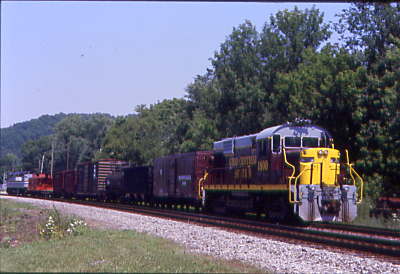
The train reversing down the main line.
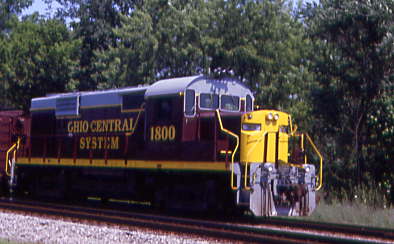
Ohio Central RS18 1800, nee Vale Inco Limited 208:2 built by American Locomotive Company in 1958.
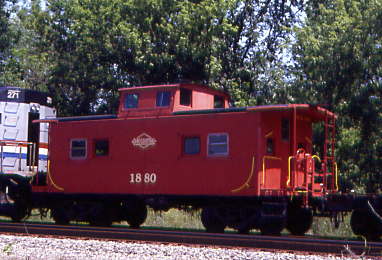
Ohio Central caboose 1880, nee Western Maryland 1880 built by the railroad in 1940.

Ohio Central F40PH 271, nee Amtrak 271 built by Electro-Motive Division in 1971.
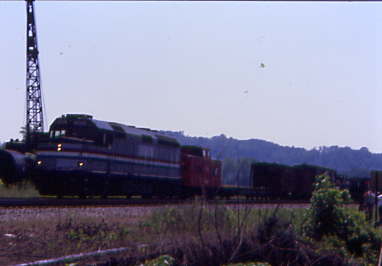
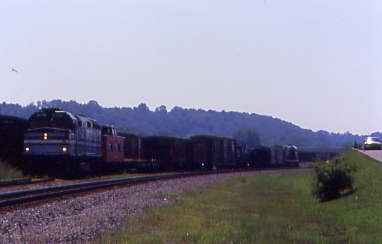
Our train continued to reverse up the siding. We drove down the road along the yard when we spotted our next prey.

Ohio Central C420 7220, nee Erie Mining Company 600 built by American Locomotive Company in 1965, which would be the power of our passenger train tomorrow.
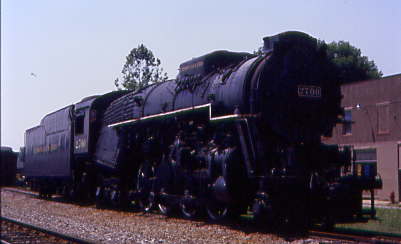
Chesapeake and Ohio K4 2-8-4 2700 built by American Locomotive Company in 1943. In 1955 it was donated to Kanawha County in Charleston, West Virginia. In 1972 the engine was donated to the City of St. Albans Firefighters Association at St. Albans, then in 1978 donated to St. Albans Railroad, Incorporated. In 1986 she was leased to the Silver Throttle Engine Association and taken to Canton, Ohio, with plans to restore it, but it stood for years on a siding where parts were progressively stripped from it.
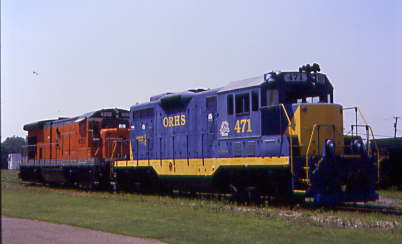
We drove by the Dennison Depot and turned across the tracks where we discovered these locomotives.
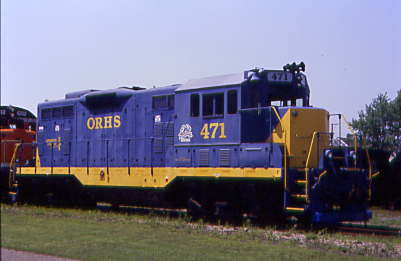
Orrville Railroad Historical Society GP7 471, nee Maine Central 571 built by Electro-Motive Division in 1950 and equipped with a steam generator to heat passenger cars and was used in both freight and passenger service. In December 1985, MEC rebuilt the engine at their Waterville, Maine shops with an upgraded "crew cab" and dynamic brakes. The high forward hood was also lowered for better visibility from the cab and the number was changed to 471. It was later repainted in Guilford Transportation colors after the MEC, Boston & Maine and Delaware & Hudson were merged.
In May 1990, the Connecticut Department of Transportation purchased the locomotive from Guilford and began operating it on the Shoreline commuter line out of New Haven with the locomotive repainted into the former New York, New Haven & Hartford Railroad "McGinnis" paint scheme. Then on April 28, 2000, 471 was acquired by ORHS in a three-way deal between HelmsFinancial Corporation, Ohio Central Rail Systems and ORHS. After months of negotiations, the locomotive was sold to ORHS at a price of $112,000, considerably below its initial asking price of $150,000. The 471 was repainted and put into full compliance with Federal Railroad Administration rules at Ohio Central's Morgan Run Shops at Coshocton, Ohio and delivered to Orrville on May 5, 2000.
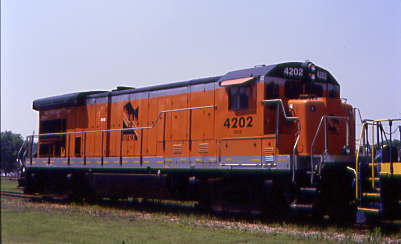
Rick Franklin Corporation B23-7 4202, ex. BNSF 4202, exx. Metro-North Commuter Railway 803, exxx. Metro-North Commuter Railway 1905, nee Conrail 1905 built by General Electric in 1978.
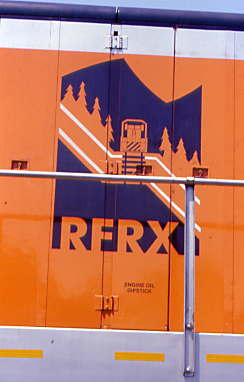
The emblem on RFRX 4202.
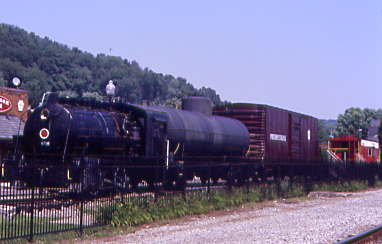
The display train at the Dennison Depot.
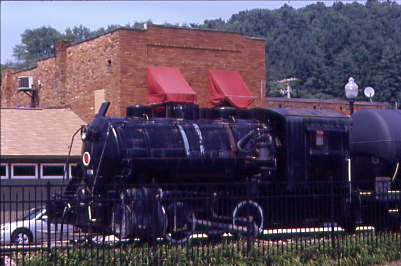
Columbus & Southern Ohio Electric 0-4-0F 3 built by Vulcan Iron Works in 1946, then moved to Groveport, Ohio and later sold to Robert Fleagane. I then met some Ohio Central employees and reeived permission to walk along the train to obtain car numbers and pictures.
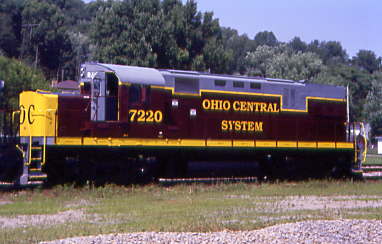
Ohio Central C420 7220.

Ohio Central RS18 1800.
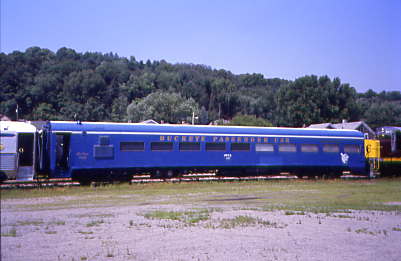
RPCX track inspection car 15013 "Buckeye Lady", ex. Grand Trunk Western 15013, exx. Amtrak 3353, nee Northern Pacific Traveler's Rest lounge car 493 built by Pullman-Standard in 1954.

RPCX 3850, originally New Haven parlour car 315 "Westerly" built by Pullman-Standard in 1948, was owned by Capitol Passenger Car and has been sold to Orrville Railroad Historical Society. Originally a 36 seat parlor car, it was rebuilt in 1964 by New Haven into 72-seat coach 7206. Penn Central re-numbered it 3196 in 1968 then when it went Amtrak, became 7256. It was rebuilt in 1973 into a 56-seat coach/parlor 3850 with an experimental airliner style interior which turned it into an oven. The history after that is sketchy until 1988 when it was discovered sitting derelict in Barberton, Ohio. The car was purchased by Capitol, moved to and rebuilt in Orrville as a 36 seat parlor.
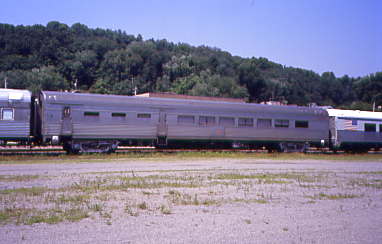
RPCX dining car 8322, ex. Amtrak 8322, nee Southern Pacific diner bar/lounge 10409 built by Budd Company in 1950 as part of the "Pride of Texas" series for the Sunset Limited.
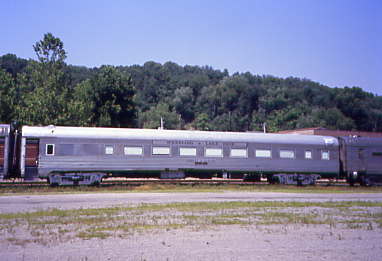
Orrville Railroad Historical Society coach 3155, ex. Wheeling and Lake Erie 103 "Robert S. Bixler", exx. Metropolitan Transit Authority of New York 86-seat commuter coach 2438 1970, nee Santa Fe 52-seat coach 3155 built by the Budd Company in 1946.
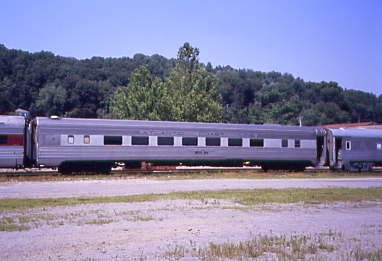
Orrville Railroad Historical Society 60-seat coach 104 "City of Orrville", ex. Amtrak 5406, exx. Seaboard Coast Line 5406, nee Atlantic Coast Line 214 built by Budd Company in 1940. It was sold to Rail Diversified in Akron who sold it then to the ORHS in 1986. The car was renamed "City of Orrville" to pay tribute to the original group from Orrville who saved the Union Depot and created ORHS.
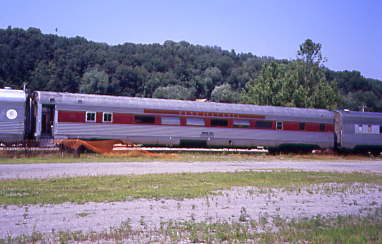
Orrville Railroad Historical Society 60-seat coach 101, ex. Amtrak 6073, exx. Amtrak 5285, exxx. Penn Central 4064, nee Pennsylvania Railroad 52-seat coach 4064 built by Budd Company in 1947. This is the car in which I rode on all three trips over the Ohio Central Railroad.
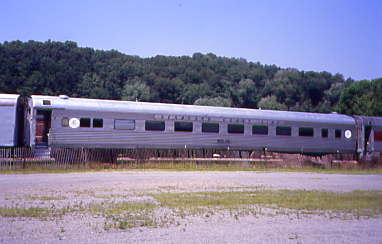
Orrville Railroad Historical Society 56-seat coach 106, ex. Valley Railroad, exx. Metropolitan Transit Authority of New York 2473, exxx. Amtrak 5607, exxxx. Seaboard Coast Line 6203, nee Seaboard Air Line 6203 built by Budd Company in 1939.
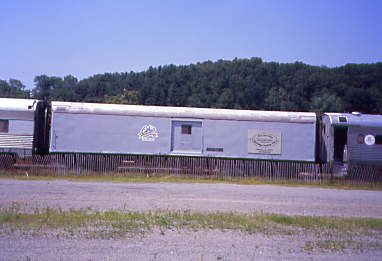
Orrville Railroad Historical Society concession car 105, ex, Amtrak streamlined baggage car 1370, nee United States Army troop kitchen car 89663 built by St. Louis Car Company in 1953.
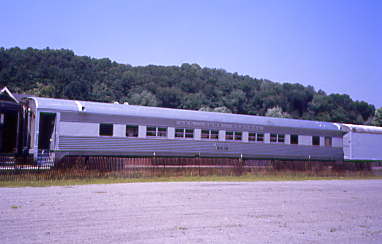
Orrville Railroad Historical Society 56-seat coach 102, ex. Amtrak 5675, exx. Penn Central 2905, nee New York Central 2905 built by Budd Company in 1947.

Cleveland Terminal and Valley Railway coach 90, nee Nickel Plate Road 90 built by Pullman Company in 1930.
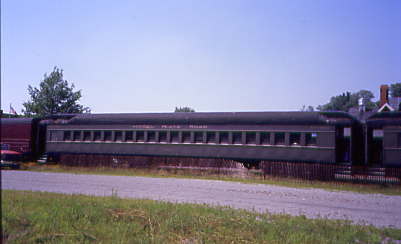
Cleveland Terminal and valley Railway coach 62, nee Nickel Plate Road 62 built by Pullman Company in 1934.
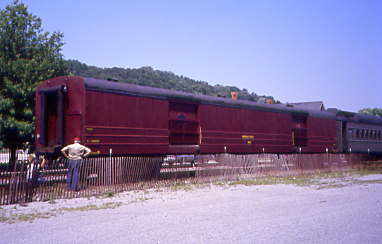
Ohio Central baggage car 5013 "Morgan Run", history unknown. Except for this car, all of the above came from the Orrville Railroad Heritage Society.
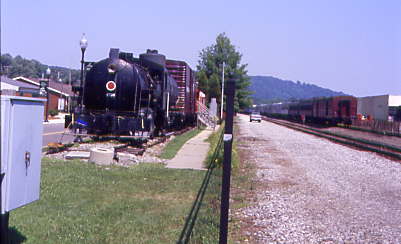
Once Chris and I were finished our photography, I thanked the Ohio Central employee and we drove to New Philadelphia.
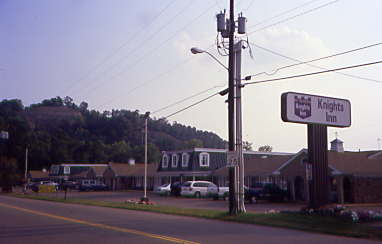
The Knights Inn, where we checked in for our six-night stay then walked across the street to the Holiday Inn where we picked up our convention packets. Chris drove me to a laundry so I could wash my clothes then I used the motel's swimming pool before we went to Hog Heaven for an excellent dinner and returned to the hotel for a night of rest before our first NRHS convention excursion the next day.
| RETURN TO THE MAIN PAGE |